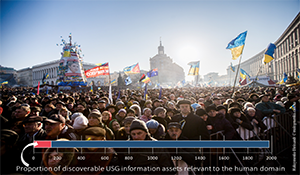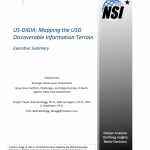US-DiGIA: USG Discoverable Information Terrain

US-DiGIA: Mapping the USG Discoverable Information Terrain.
Author | Editor: Bragg, B., Pagano, S. & Stevenson, J. (NSI, Inc.).
Executive Summary
The United States currently faces a complex and dynamic security environment. States are no longer the only critical actors in the international arena; rather, a diverse range of non-state entities also has the potential to affect US interests and security—for good or bad. Economic influence, information control and propaganda, political influence, and social discontent can be and are being utilized by state and non-state actors alike to achieve their goals, in many cases bypassing the need for direct military action. In response, the US military is challenged to accomplish more, across a greater variety of domains, while facing a constrained budget environment. There are two central implications of this: first, many of the most intractable security problems the US faces require a whole of government approach. Second, in a complex and evolving international environment characterized by new and often ambiguous threats, information itself is a critical asset.
If USSOCOM and others were able to leverage these existing extant sources of information, data and expertise (i.e. information assets) held by the USG, the cost and time savings from avoiding duplication of effort would be potentially immense. In an effort to enable this, the NSI team “mapped” the USG information terrain, cataloguing all discoverable (unclassified, published, and referenced or held online) information assets relevant to national security and foreign policy held across the non-DoD and non-ODNI USG organizations.
This effort resulted in the Directory of Discoverable US Government Information Assets (US-DiGIA), which provides a tool that enables users to search for and locate open source USG information assets, and possible points of contact for interagency collaboration. The structure of the US-DiGIA is shown in Figure 1 below.
Key Findings
The US-DiGIA Directory can also be analyzed to provide an overview of the USG discoverable information terrain. This report presents some of the key findings of our analysis of the directory. Part 2 focuses on the subset of information assets relevant to gray zone challenges. It also demonstrates how tailored coding for specific issues or security concerns can increase the utility of the US-DiGIA directory for users with specific information needs.
We organized our analysis in each part around the three foundational whole-of-government questions that guided the structure of the directory itself.
- What national security and foreign policy related information does the USG currently collect and hold?
- Who (which organizations) collects and holds that information?
- Where geographically are our information assets focused?
Part 1: US-DiGIA Directory as a whole
What National Security and Foreign Policy Related Information Does the USG Hold?
Who Collects and Holds that Information?
- The State Department has both the greatest quantity (501 information assets) and diversity (387 topics) of information relevant to national security and foreign policy.
- Many organizations outside the intelligence community (IC), or the group of organizations that frequently coordinate with the DoD1, were found to have information potentially relevant to national security and foreign policy.
- Although the Departments of Health and Human Services, Labor, Interior, and Energy all hold fewer overall assets than other organizations, they cover a broader range of topics.
- The Department of Health and Human Services (DHHS) has a, perhaps surprising, number of relevant information assets (99), and many of these assets relate to disease detection and tracking or emergency response.
Where Geographically is that Information Focused?
- Internationally focused discoverable information assets were more numerous than were US focused.
- Identifying which information assets cover specific CCMD AORs is in many cases not possible from the published descriptions. This creates inefficiencies when searching for country or region specific information, and it makes it harder to identify countries or regions where gray zone relevant information is lacking.
Implications
Information
Lack of information leaves us functionally blind to potential opportunities to further US interests or mitigate threats to those interests. Without reliable information, it is more likely that we may incorrectly classify an action as gray and increase the risk of either unintended escalation (by assuming an action is gray when it is not) or missing threats to our interests (by assessing an action as not gray when it is in fact gray).
The ability to identify and locate information assets across a broad range of USG organizations could reduce the need for SOCOM and others to undertake their own information collection efforts. This in turn increases the efficiency of information collection and reduces cost in both time and resources.
The current scarcity of information related to potential gray actions places the US at a disadvantage when it comes to developing indicators and warnings. These gaps highlight areas where SOCOM and others could focus their own information collection efforts to maximize efficiency and impact for analysts and planners.
Whole of Government
Appreciation of the complexity of the evolving security environment has prompted calls for a whole of government approach to national security challenges. Information exchange is a logical first step in increasing awareness of common interests and information assets across the USG, and the US- DiGIA Directory can contribute to that process.
The types of discoverable information an office with an organization holds also provide an indication of the interests and expertise within that office and thus a guide to the identification of possible points for interagency cooperation. Interagency collaboration enables the practitioners who best understand specific instruments of power to be involved in their application to specific national security (including gray zone) challenges.
Similarly, bringing diverse areas of expertise and authorities together can reduce institutional bias, and reveal underlying assumptions. This can create the potential for developing a broader and more adaptive set of strategies for responding to gray zone and other national security threats and avoiding unintended consequences.

Comments